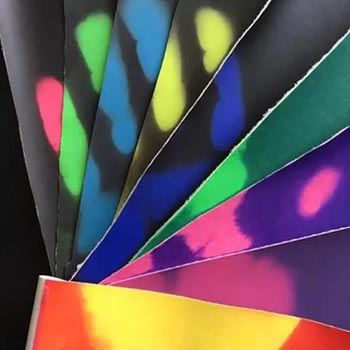All color-changing pigments do not contain mercury, lead, chromium and other toxic heavy metals, and are non-toxic and non-irritating to human skin. However, because its particles are very small, after the formation of dust in the air, it is easy to enter the human lung by the respiratory tract or enter the blood circulation system, causing adverse consequences. Therefore, wear a dust mask, rubber gloves and goggles during operation. If the color-changing pigment accidentally enters the eyes or mouth, wash it immediately with plenty of water to prevent it from entering the human body.
According to the relevant regulations of the State, color-changing pigments are the same as ordinary pigments, and the parts containing pigments in their products should avoid direct contact with food and drinking water. If it is used to produce plastic catering utensils with temperature discoloration, a double-layer injection molding process can be used, and the discoloration layer should be located in the part that is not in contact with food.
Thermochromic pigments are non-flammable and will not spontaneously ignite when heated to 170 ° C in the air. However, due to its extremely fine particles and huge specific surface area, once dust is formed in the air and reaches a certain concentration, it may cause deflagration in case of open fire. Exercise caution when performing this operation.
Conditions of use of thermochromic pigments:
Reversible thermochromic pigment itself is an unstable system (stability is difficult to change), so its light resistance, heat resistance, aging resistance and other properties are far less than ordinary pigments, which should be paid attention to in use.
1, light resistance:
Thermochromic pigments have poor light resistance and will fade quickly under strong sunlight exposure, so they are only suitable for indoor use. Strong sunlight and ultraviolet light should be avoided, which is conducive to extending the service life of discolored pigments.
2, heat resistance:
Thermochromic pigments can withstand 230 ° C high temperature (about 10 minutes) in a short time, and can be applied to injection molding and high temperature curing. However, the thermal stability of color-changing pigments is different in the color state and the achromatic state, and the stability of the former is higher than that of the latter. In addition, when the temperature is higher than 80 ° C, the organic matter that constitutes the discoloration system will also begin to degrade. Therefore, color-changing pigments should avoid working at temperatures higher than 75 ° C for a long time.
Preservation of thermochromic pigments:
This product should be stored in a cool, dry and completely away from light. Since the stability of color-changing pigments in the color state is higher than that of the achromatic state, varieties with lower color-changing temperatures should be kept in the freezer. Under the above conditions, the performance of most varieties of color-changing pigments does not deteriorate significantly after 5 years of storage.
